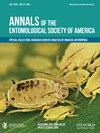Response of Beetle Assemblages (Insecta: Coleoptera) to Patch Characteristics and Habitat Complexity in an Ever-Expanding Urban Landscape in the Yucatán Peninsula, Mexico
IF 3
3区 农林科学
Q1 ENTOMOLOGY
引用次数: 0
Abstract
Abstract Insect diversity levels and change in remnant urban habitats have been poorly examined in Neotropical regions. The aim of this study was to evaluate the diversity and composition of foliage/shrub dwelling beetles (Insecta: Coleoptera) regarding the influence of patch attributes (i.e., patch size, connectivity, and surrounding matrix) and within-patch habitat complexity, in an urban landscape at Chetumal, Yucatán peninsula, Mexico. Despite the potential species-specific responses to urban landscape pattern, our study reveals that there are effects of patch spatial features and habitat complexity on overall beetle diversity.These effects are as follows: 1) relatively larger urban patches contained higher overall beetle richness, 2) beetle species composition varied significantly regarding understory vegetation structure and tree richness, and 3) patches of intermediate vegetation age had highest beetle richness.This research provides a case study of patch and habitat features related to Neotropical insect assemblages in urban settlements, underlying the importance of using ecological information to offer management recommendations in ever-expanding urban tropical settlements.墨西哥尤卡坦半岛不断扩大的城市景观中甲虫群落(昆虫纲:鞘翅目)对斑块特征和栖息地复杂性的反应
摘要在新热带地区,昆虫多样性水平和残余城市栖息地的变化研究很少。本研究的目的是在墨西哥尤卡坦半岛Chetumal的城市景观中,评估叶/灌木甲虫(昆虫纲:鞘翅目)的多样性和组成,以及斑块属性(即斑块大小、连通性和周围基质)和斑块内栖息地复杂性的影响。尽管对城市景观模式有潜在的物种特异性反应,但我们的研究表明,斑块空间特征和栖息地复杂性对甲虫的整体多样性有影响。这些影响如下:1)相对较大的城市斑块具有较高的总体甲虫丰富度,2)甲虫物种组成在林下植被结构和树木丰富度方面差异显著,3)中等植被年龄的斑块具有最高的甲虫丰富度。这项研究提供了一个与城市住区中新热带昆虫群落相关的斑块和栖息地特征的案例研究,揭示了在不断扩大的城市热带住区中使用生态信息提供管理建议的重要性。
本文章由计算机程序翻译,如有差异,请以英文原文为准。
求助全文
约1分钟内获得全文
求助全文
来源期刊
CiteScore
4.90
自引率
0.00%
发文量
25
审稿时长
6-12 weeks
期刊介绍:
The Annals of the Entomological Society of America exists to stimulate interdisciplinary dialogue across the entomological disciplines and to advance cooperative interaction among diverse groups of entomologists. It seeks to attract and publish cutting-edge research, reviews, collections of articles on a common topic of broad interest, and discussion of topics with national or international importance. We especially welcome articles covering developing areas of research, controversial issues or debate, and topics of importance to society. Manuscripts that are primarily reports of new species, methodology, pest management, or the biology of single species generally will be referred to other journals of the ESA. The most important criteria for acceptance are quality of work and breadth of interest to the readership.

 求助内容:
求助内容: 应助结果提醒方式:
应助结果提醒方式:


